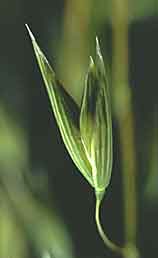Wild Oats: A crop mimic
The most difficult types of weeds to control are those that mimic the crop. Wild oats (Avena fatua) is a well known example in Canada. The vegetative plants are virtually indistinguishable from domesticated oats (Avena sativa), and a farmer may have little inkling they are in the field until he or she harvests the crop and what looks like a good harvest turns out to be a very poor one. If she looks at the awns on the maturing plants, she can spot the wild oats - but by then it is too late!
The seed heads of wild oats shatter* naturally or when they are impacted by the combine, releasing the seeds to the soil rather than being collected in the combine. Wild oats are difficult to control with herbicides because they are closely related to the crop.
*(Seed heads of domesticated grain crops do not shatter naturally, and so are picked up by the combine; the combine thrashes them releasing the seeds inside the combine).
Crop mimics have emerged as signficant problems in some intensive crop production systems. The highly effective control of other weed species reduces compeititon of those species with the mimic and the use of herbicides that kill species other than those which have a metabolism similar to that of the crop, selects for weeds that are similar to the crop.
Crop rotations, undersowing with clover and non-intensive control of weeds help to reduce the mimics to low levels.

Above: Seeds and glumes of oats (light colored), and the empty glumes of wild oats (dark) taken in a combine.

Domestic oats (left) and wild oats (right) grown in pots. The wild oat is as big and vigorous as the domestic oat (and even more so in this trial), and were it not for the shattering seed head, would make a good crop.

Green glume of wild oats with long awn

Green glume of domestic oats